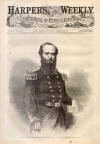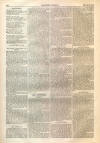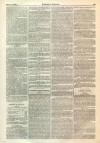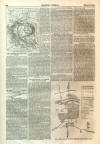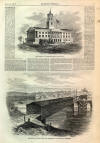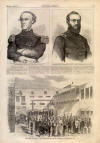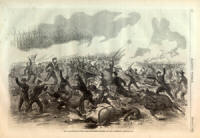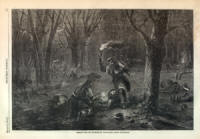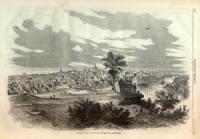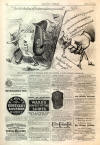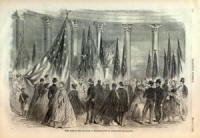General Grant Biography
|
|
This Site:
|
MARCH 8, 1862.] HARPER'S WEEKLY. 151 (Previous Page) received while in your town. At the little house you see marked at the left of (7) Company E, Captain Carroll, killed twenty-one men. We fairly mowed them down in that open field. The Ninth Ohio (13) was carrying on the same kind of business on the other side of the road. The order was again given to charge bayonets, which was done by the Tenth Indiana and Ninth Ohio in splendid style. Secesh was now completely played out, and they all struck for their den. The double-quick we practiced so much at Bardstown was no comparison to theirs; in that respect they are much better drilled than we. We followed them, occasionally giving them a shell to hurry them up a little. At about 4 o'clock we arrived within shelling distance of their intrenchments, and commenced giving them a few; but night coming on we decided to rest. We had started off in the morning before breakfast, and had eaten nothing all day. We received a few crackers, and the boys laid themselves down on the damp ground (it having rained all day). In the morning Whitmore's battery was ordered up to shell a steamboat which we saw crossing the river. We shot with two Parrot guns a distance of about two miles. We however had shot but a few times when we noticed the steamer on fire. Our regiment, together with the Tenth Kentucky, Fourteenth Ohio, and Fourth Kentucky (Manson's Brigade), were then ordered by General Thomas to take possession of the intrenchments. The Tenth Kentucky, Colonel Harlan, was the first to enter, the Fourteenth Ohio next, and then came ours. We found every thing left. Horses stood saddled and bridled; teams were hitched up; the horses were standing attached to the cannons; officers' trunks were found strewn on the bank of the river. We took about 2000 head of horses and mules, 250 wagons, 14 cannon, two of which were captured by them at Bull Run, some 4000 or 5000 stand of arms, and any number of flags. Company E, Captain Carroll, captured three silk flags; Company H, Captain Marsh B. Taylor, one silk flag. You have seen it reported in the papers that Colonel Fry and Zollicoffer had some conversation, and that Fry shot Z. This is a great hoax. Zollicoffer was shot three times; the ball that killed him was from an Enfield rifle, and entered his heart. The shot was fired by Corporal James Swan, of Company H, who is a dead shot, and the same person who shot the man one night in the shoulder while in your town. I am, Judge, very proud to be in the Tenth Regiment, and also very proud of the officers. They are all very brave. Colonel Kise and Major Miller can't be beat any where. Colonel Manson was the hero of the day, and managed every thing in splendid style. We lost but one officer, Lieutenant M'Adams, who was shot in the forehead and killed instantly. Lieutenant Johnson was wounded in the left arm slightly. Some of the men were wounded, and after having their wounds bound up went into the field again. At one time we were so close to the enemy that we bayoneted them through the fence. The Mississippians were armed with immense knives, which they intended using on us, but our bayonets outreached their knives. MAJOR-GENERAL GRANT.WE publish on page 145 a portrait of MAJOR-GENERAL GRANT, the hero of Fort Donelson. The following sketch of his life we take from the Herald: Major-General Ulysses S. Grant was born at Point Pleasant, Clairmont County, Ohio, April 27, 1822, and entered West Point Military Academy from Ohio in 1839, where he graduated with honors in 1843, and was attached as brevet Second Lieutenant to the Fourth Infantry. He was promoted Second Lieutenant at Corpus Christi, in September, 1845, and served as such through Mexico, under General Taylor, at Palo Alto, Resaca de la Palma, and Monterey, and under General Scott from Vera Cruz to the city of Mexico, and was twice promoted for his bravery. He was regimental Quarter-master from April 1, 1847; and when he resigned the service, on the 31st of July, 1854, he was a full captain in the Fourth Infantry of regulars. After his resignation he settled in St. Louis County, Missouri, and moved front there to Galena, Illinois, in 1860. Upon the breaking out of the present war he offered his services to Governor Yates, and was appointed Colonel of the 21st Regiment of Illinois Volunteers, and served with his regiment until promoted a Brigadier-General, with commission and rank from the 17th of May, 1861. He was engaged as Colonel and acting Brigadier-General in several of the contests in Southeastern Missouri; and his course as commander of the southeast district of Missouri has been thoroughly scrutinized, and among his most praiseworthy acts was the occupation of Paducah, and stoppage of communication and supplies to the rebels via the Tennessee and Cumberland rivers. The manner in which he conducted the battle of Belmont is still fresh in our readers' minds. The rest of his course as commander there is too well known to be repeated here, and certain it is that this action in every instance has been applauded both by his superior officers and the people. After the capture of Fort Henry a new district was created, under the denomination of the District of West Tennessee, and General Grant was assigned by General Halleck to the command of it. General Grant's performance at Fort Henry, and especially his correspondence with the rebel General Buckner, are fresh in our readers' memories. He was at once appointed a Major-General by the President, and was unanimously confirmed by Congress. BRIGADIER-GENERAL GARFIELD.On page 157 we publish a portrait of BRIGADIER-GENERAL GARFIELD, who defeated and scattered Humphrey Marshall's rebel army shortly after New-Year. General Garfield's exploit is thus described in his own official orders: PAINTVILLE, Jan. 8, 1862. Captain J. B. Fry, Assistant Adjutant-General: I entered this place yesterday, with the Forty-second Ohio regiment, Fourteenth Kentucky regiment, and three hundred of the Second Virginia cavalry. On hearing of my approach the main rebel force left their strongly intrenched camp and fled. I sent my cavalry to the mouth of Jennis Creek, where they attacked and drove the rebel cavalry, which had been left as a van-guard, a distance of five miles, killing three and wounding a considerable number. Marshall's whole army is now flying in utter confusion. He had abandoned and burned a large quantity of stores. We have taken fifteen prisoners. Our loss was two killed and one wounded. I start in pursuit to-morrow morning. J. A. GARFIELD, commanding Brigade. BRIGADE, PRESTONBURG, KY , Jan 11, 1862. Captain J. B. Fry, Assistant Adjutant-General: I left Paintville on Thursday noon with 1100 men, and drove in the enemy's pickets two miles below Prestonburg. The men slept on their arms. At four o'clock yesterday morning we moved toward the main body of the enemy, at the forks of Middle Creek, under the command of Marshall. Skirmishing with his outposts began at eight o'clock, and at one o'clock P.M. we engaged his force of 2500, with three cannon posted on the hill. We fought them until dark, having been reinforced by about 700 men from Paintville, and drove the enemy from all his positions. He carried off the majority of his dead and all his wounded. This morning we found twenty-seven of his dead on the field. His killed can not be less than sixty. We have taken twenty-five prisoners, ten horses, and a quantity of stores. The enemy burned most of his stores, and fled precipitately in the night. Today I have crossed the river, and am now occupying Prestonburg. Our loss is two killed and twenty-five wounded. J. A. GARFIELD, Colonel commanding Brigade. All is quiet down the road. WASHINGTON'S BIRTHDAY AT WASHINGTON.WE illustrate on page 156 the REBEL FLAGS in the old House of Representatives at Washington, on the occasion of the celebration of Washington's Birthday. The Senate had adjourned, and Senators had taken seats in the House, and at one o'clock the Heads of Departments, Chief Justice and Associate Justices of the Supreme Court, Foreign Ministers, and the principal Officers of the Army and Navy in full uniform, appeared at the door, and were admitted to the floor of the House. The galleries were densely crowded with well-dressed ladies and men. The ceremonies began with a prayer by Chaplain Stockton, and the Clerk then read Washington's Farewell Address in a clear, loud voice. The day was celebrated with eclat in all the large cities of the North. The correspondent of the Evening Post gives the following account of the gathering in the Hall of Representatives: Mr. Seward was there, impassible as ever, with a sandy and tough face, on which the sharp contests of a long life of New York and national politics would seem to have made no impression. Beside him was the Attorney-General, whose office in these times is somewhat lessened in the light of the maxim, "leges silent inter arma." Mr. Blair, with his tall lithe figure, sharp eye, and intelligent face, sat next Mr. Caleb Smith, whose very countenance would indicate that the toils of the Interior Department are alleviated by a good digestion and a mind at ease. The new Secretary of War was present, with his broad, massive head, and lines that spoke decision on his face, which was pale to-day. And Welles, of the Navy, who, in spite of all the Morgan talk, is esteemed an upright and able man, was there, with his patriarchal long white locks, and a face which seemingly belongs as little to to-day as if he had been the sculptor employed by the kings before the Pharaohs to carve the Sphinx. General McClellan was the most observed of observers. 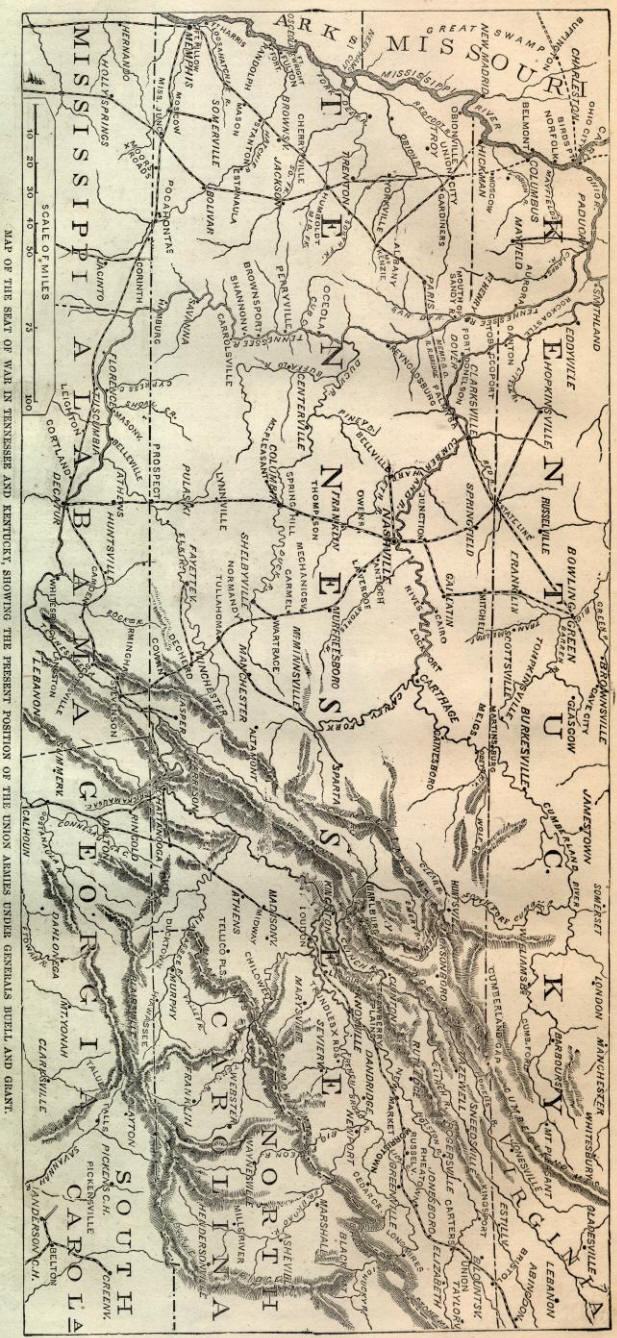 |
||||||||||||||||||||||||||||
|
|
||
|
|
Site Copyright 2003-2018 Son of the South. For Questions or comments about this collection, contact paul@sonofthesouth.net |
|
|
Are you Scared and Confused? Read My Snake Story, a story of hope and encouragement, to help you face your fears. |
||
